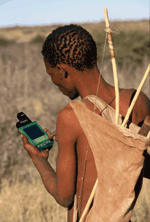
Country Focus: Innovation to Drive Development - A South African Perspective
By Dr. Sibongile Pefile
Dr. Sibongile Pefile is responsible for Research and Development Outcomes at the South African Council for Scientific and Industrial Research (CSIR). In this article for WIPO Magazine she explores how innovation can be fostered to further socio-economic development in developing countries, and she highlights some recent South African innovations which illustrate this.
At the CSIR, our business is to foster industrial and scientific research and technological innovation in collaboration with the private and public sector in order to contribute to improving the quality of life of the people of South Africa. Our focus is on promoting and transferring innovative technologies and scientific knowledge in a sustainable manner, with an emphasis on technologies that have a high potential for impacting positively on communities.
Innovations and inventions
So what does this mean? And how does a developing country like South Africa create the conditions necessary to stimulate – and benefit from – the innovative capacity of its institutions and people? It does no harm to start at the beginning and take a moment to consider what is meant by innovation. A useful way of looking at it is that creativity is the generation of new ideas, inventions are new discoveries that can be patented and provide a solution to a problem, while innovation is their commercialization and exploitation. Therefore, innovation is the application of the solution in society or the economy. It is possible to be innovative, yet never invent anything.
| The CyberTracker |
|---|
|
A hand-held computer, connected to a satellite navigational system, provides a high-tech method of tracking animals in the field. Invented in 1996 by environmentalist Louis Liebenberg and Lindsay Steventon, it combines traditional tracking skills with state-of-the-art computer and satellite technology.
CyberTrackers are currently being used in major parks such as the Karoo National Reserve to map animal movements and breeding patterns as part of a major conservation project. A graphic interface enables illiterate trackers to enter detailed information, so helping scientists to carry out their research. |
Systems of innovation
Much work has been done to study the different elements which combine to facilitate innovation in a given sector. For innovation to occur, scientific, business and institutional knowledge is required from different sources. So a "system of innovation" is based on a network within an economic system, which connects the different organizations or stakeholders involved in the creation, adoption, use and diffusion of scientific and technological knowledge. The context and institutions involved govern the nature of the interactions and processes that take place in a system of innovation. Innovation results from this interactive process between such stakeholders. It is not a linear process, but an iterative process with feedback loops between the different stages.
To promote a system of innovation requires:
- support for R&D;
- an active public sector;
- manufacturing, trade and industry capability;
- creation of domestic markets;
- development of export markets;
- creation of intellectual property systems;
- creation of the appropriate policy environment.
These determinants are dynamically linked, in that progress in one is facilitated by progress in all.1 And similarly, a lack of progress in one impedes progress in others. So a coherent strategy for innovation should address each of the determinants. Simply put, the innovative performance of an economy depends not only on the performance of each determinant, but on how they interact with each other as elements of a collective system.
The innovation chasm
Some noteworthy innovations have originated from South African institutions as these pages show (see images). But how much more creativity lies untapped, or has fallen into what has become known as the innovation chasm?
When one looks at the process through which inventions and discoveries are brought to market, the R&D phase is often funded using public money. Once a product has been developed and tested, private sector investment funding, ideally, should take over. In the absence of early technology investors, the problem is, who pays for the cost of development work, such as testing prototypes, developing the business plan, or for the transfer of know-how associated with a technology? This funding gap, or innovation chasm, is the gap between, on one side, research, and on the other side, the application of products/services created from technologies developed from such research. Many developing countries with moderate R&D activity suffer from an innovation chasm because they fail to bridge the gap between knowledge generation and knowledge application.
| The Mine Burner |
|---|
|
Developed with funding from the CSIR and the Department of Trade and Industry, the MineBurner aims to slash the costs of de-mining operations and reduce the deaths caused by landmines worldwide. The device burns up the explosive compound in the mine, rather than exploding it, making it safe to use in built-up areas. The inventor, Paul Richards, explains: "MineBurner uses patented pressure technology to deliver exactly the right amount of oxygen and LPG (cooking gas) at the right pressure to burn out the mine. It uses materials which can be sourced and manufactured locally, thereby cutting down cost." The UN estimates the cost of removing a landmine using traditional methods at between US$300 and US$1,000. The equivalent cost using the MineBurner is estimated at only 20 cents. |
Social issues
Technology transforms the way in which we do business and lead our lives. Difficult tasks can become simpler when innovative products and processes are applied. But most new technologies are still not reaching those who most need them. Access continues to be limited by factors such as the cost of new products, and the fact that the private sector, in the interest of shareholders, is more concerned with investing in products that have potential for high returns rather than good social impact.
Increasing the capacity to innovate to improve the human condition of the poor is our most important challenge. A simple initiative such as bringing clean water and sanitation to homesteads significantly reduces disease and saves lives in developing countries. Innovations do not always have to be sophisticated to be effective and have impact. What is important is that they must be appropriate and reach the communities that need them most – in the way that the Play Pumps have transformed the lives of some South African rural communities.
IP can be an emotive issue in the context of creating an enabling environment for socio-economic development in developing countries. But international IP laws exist, as do national IP laws now in many developing countries, and the way I see it, we should be asking, how can IP be managed creatively in order to benefit from it? For developing countries to benefit from IP rights systems requires capacity and awareness building so that decisions, such as whether or not to patent, or to whom and how to license, are made from a knowledgeable standpoint.
Innovation to bridge the development gap – challenges ahead
Is it realistic to expect developing countries to grow in the same leaps and bounds as developed countries that have benefited from a series of significant technological innovations over centuries? To do so they must meet the following challenges:
- Finance . The challenge for developing countries involved in R&D is to bring to market the stream of new, improved or added-value products or services. In the present situation, it is more difficult for developing country governments to allocate funds to initiatives that, often, have intangible, long-term outcomes.
- Managing innovation . In order to derive benefits from the innovative capacities of R&D institutions, one needs to build institutional capacity to transfer technology from the lab to the market. Once in the market, the technology should go through acceptance and adoption, widespread diffusion and, ultimately, its demise as other technologies take over the industry.
- Education and training For many institutions, managing innovation is an emerging area. A major challenge for any research organization, whose aim is to pursue research, is to find ways to transfer their ideas into practical advances – in other words to be effective in technology transfer. Innovation management requires multidisciplinary teams capable of breaking down the barriers that stand in the way of technology adoption. To achieve this, education, training and practical experience is key.
- Time Various actors and social groups play a role in the diffusion of innovation. Innovation is a process which takes time to show tangible results and for its impact to be felt. These time factors have to be taken into consideration.
- Critical mass It is essential to attain a critical mass in areas of strategic research and socio-economic development. The right skills must be developed to identify and exploit inventions and discoveries for societal benefit and economic gain, and to build research capabilities to enable the production of new or improved technologies.
- Sustainability In an environment of scarce and precious resources, the issue of sustainability is of great significance. Technologies need to address industry and community needs in a sustainable manner.
- Leadership Leadership in the creation of new technology is of prime importance, and nobody will be surprised to hear of the tensions that exist between the ambitions of a creative scientist, the demands of the market and the availability of resources. Leadership is required to ensure that such tensions are managed and that the focus is on progress.
- Measuring impact How will we know whether or not the outcomes of R&D are making a difference in the world today? Measuring impact will ensure that we remain on track of set objectives and are accountable for delivery and the use of scarce resources.
Our challenge is to ensure that innovation is encouraged at all levels of the economy, and that the impact is positive on society. One way to achieve this is by opening the door to those who, in the past, have not been able to participate in the economy in a meaningful way. A challenge indeed!
The WIPO Magazine is intended to help broaden public understanding of intellectual property and of WIPO’s work, and is not an official document of WIPO. The designations employed and the presentation of material throughout this publication do not imply the expression of any opinion whatsoever on the part of WIPO concerning the legal status of any country, territory or area or of its authorities, or concerning the delimitation of its frontiers or boundaries. This publication is not intended to reflect the views of the Member States or the WIPO Secretariat. The mention of specific companies or products of manufacturers does not imply that they are endorsed or recommended by WIPO in preference to others of a similar nature that are not mentioned.

